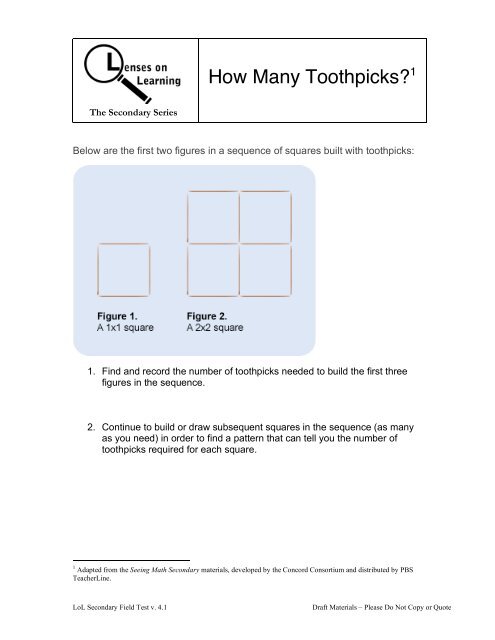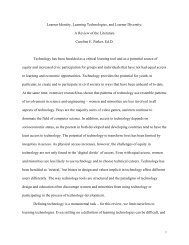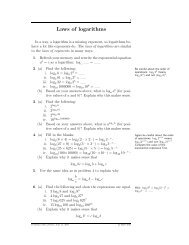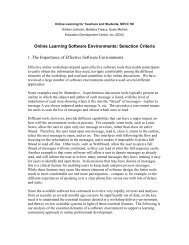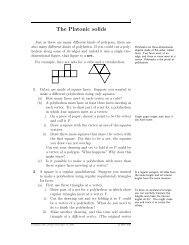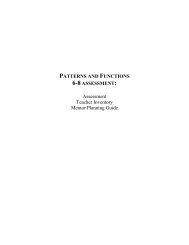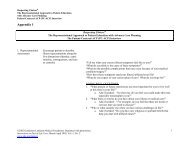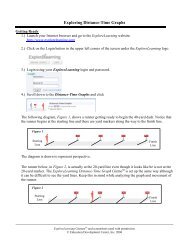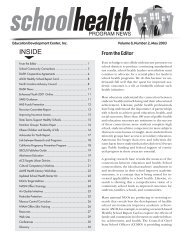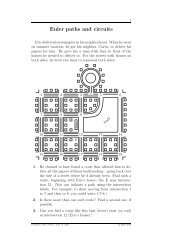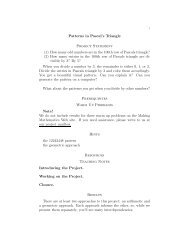How Many Toothpicks?1
How Many Toothpicks?1
How Many Toothpicks?1
- No tags were found...
Create successful ePaper yourself
Turn your PDF publications into a flip-book with our unique Google optimized e-Paper software.
<strong>How</strong> <strong>Many</strong> <strong>Toothpicks</strong>? 1The Secondary SeriesBelow are the first two figures in a sequence of squares built with toothpicks:1. Find and record the number of toothpicks needed to build the first threefigures in the sequence.2. Continue to build or draw subsequent squares in the sequence (as manyas you need) in order to find a pattern that can tell you the number oftoothpicks required for each square.1 Adapted from the Seeing Math Secondary materials, developed by the Concord Consortium and distributed by PBSTeacherLine.LoL Secondary Field Test v. 4.1Draft Materials – Please Do Not Copy or Quote
3. Predict the number of toothpicks needed to build an 8 x 8 square and a 21 x 21square. <strong>How</strong> would you verify your prediction?4. Write a rule to describe the number of toothpicks needed to build thefigure with dimensions n x n, for any positive integer, n.LoL Secondary Field Test v. 4.1Draft Materials – Please Do Not Copy or Quote
Optional: Further scaffolding for entering the <strong>How</strong> <strong>Many</strong> <strong>Toothpicks</strong>? problemIf, after making a good effort to grapple with the initial framing of the problem, youand your group determine that some additional structure would be helpful, thefollowing set of directions and questions can guide you to organize your thinkingaround one approach to the task (which is actually an approach taken by onegroup of the students we will view in the video, later in this session).1. Use toothpicks to build the next figure in the pattern (a 3 x 3 square). Thendraw Figure 3 on grid paper to keep track of your data.2. Find and record the number of toothpicks in the perimeter of the first threefigures in the pattern. <strong>How</strong> would you predict the number of toothpicks inthe perimeter of an 8 x 8 square? Write an algebraic rule for determiningthe number of toothpicks for any n x n square.3. Find and record the number of toothpicks in the interior of the first threefigures in the pattern. <strong>How</strong> would you predict the number of toothpicks inthe interior of an 8 x 8 square. Does this help you predict the number oftoothpicks for any n x n square? <strong>How</strong> might you write this as a rule?4. Predict the total number of toothpicks in a 4 x 4 square. A 5 x 5 square.Record your predictions in a table. Then, draw the squares on grid paperand check if your predictions are correct. Label them Figure 4 and Figure5.5. <strong>How</strong> would you determine the total number of toothpicks in an 8 x 8square?6. <strong>How</strong> would you determine the total number of toothpicks for any n x nsquare?LoL Secondary Field Test v. 4.1Draft Materials – Please Do Not Copy or Quote
Student A’s approach<strong>How</strong> is this student dividing up her toothpicks?<strong>How</strong> does she use these patterns to help her find a pattern for the number oftoothpicks in each of these figures?Describe, in words, how the number of toothpicks grows.Make use of Student A’s approach to write a rule for the number of toothpicks inany figure. (It should simplify to the rule you found already, but it might not look thesame initially)LoL Secondary Field Test v. 4.1Draft Materials – Please Do Not Copy or Quote
Student B’s approach<strong>How</strong> is his student dividing up his toothpicks?<strong>How</strong> does he use these patterns to help him find a pattern for the number oftoothpicks in each of these figures?Describe, in words, how the number of toothpicks grows.Make use of Student B’s approach to write a rule for the number of toothpicks inany figure.LoL Secondary Field Test v. 4.1Draft Materials – Please Do Not Copy or Quote
Taking the task to the next level:1. What is similar and different about the rules generated by Student A and B?2. Why does one figure subtract 1 from n, and the other add 1 to n?3. Will both of these rules work for all figures? <strong>How</strong> can you prove it?Making sense of two more approaches – In what ways do the following expressionsrepresent the figures below them?A. 4n + (n2 - n)∗2!B. 4 + 2(n-1) ∗ 3 + (n – 1)2 ∗ 2!LoL Secondary Field Test v. 4.1Draft Materials – Please Do Not Copy or Quote


